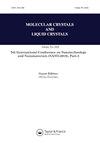含有蝇唇须的旁膜对刺激物质的反应
Molecular Crystals and Liquid Crystals Science and Technology. Section A. Molecular Crystals and Liquid Crystals
Pub Date : 2001-10-01
DOI:10.1080/10587250108030103
引用次数: 1
摘要
摘要:从蝇唇须中提取一组分子,将其重组为平面双层膜和脂质体,构建味觉传感器。通过平面双层膜实验证实了蝇唇须提取物中钠离子通道的存在。荧光染料Di-8-ANEPPS对膜电位的变化非常敏感,用于阐明该系统在传感器应用中的可用性。脂质体的荧光强度与盐溶液(膜电位)的浓度成正比。添加河豚毒素(钠离子通道阻滞剂),成功地将蝇唇须提取物中的钠离子通道重构为脂质体。本文章由计算机程序翻译,如有差异,请以英文原文为准。
Response by Bylayer Membranes Containing the Labial Palpus of Fly to Stimulative Substances
Abstract A group of molecules extracted from the labial palpus of fly was reconstituted into plannar bilayer membranes and liposomes to construct the taste sensors. The existence of sodium ion channel in the extract of the labial palpus of fly was recognized by the plannar bilayer membrane experiment. Fluorescent dye, Di-8-ANEPPS, which is very sensitive to the change to the membrane potential, was used to clarif the availability of this system for sensor applications. The fluorescence intensity of liposomes was proportional to the concentration of salt solution (membrane potential) added as stimulative substances. Addition of tetrodotoxin (sodium channel blocker) revealed that sodium ion channel in the extract of the labial palpus of fly was successfully reconstituted into liposome.
求助全文
通过发布文献求助,成功后即可免费获取论文全文。
去求助
来源期刊
自引率
0.00%
发文量
0

 求助内容:
求助内容: 应助结果提醒方式:
应助结果提醒方式:


